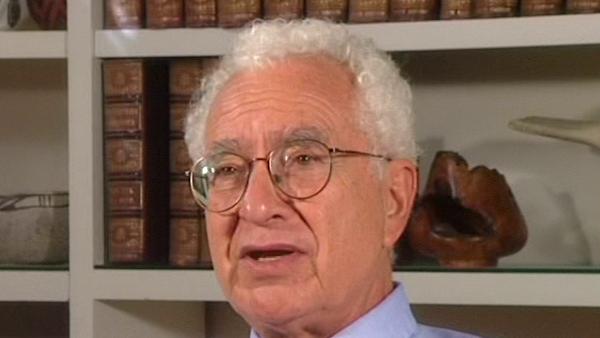NEXT STORY

Talking to Fermi, the theory of high angular momentum
RELATED STORIES

NEXT STORY

Talking to Fermi, the theory of high angular momentum
RELATED STORIES


|
Views | Duration | |
|---|---|---|---|
| 61. Isotopic spin | 1103 | 03:37 | |
| 62. Explaining Dave Peaslee's letter | 947 | 04:17 | |
| 63. Giving talks on the idea of isotopic spin | 896 | 03:46 | |
| 64. Almost getting drafted; a letter to the Physical Review | 1064 | 02:05 | |
| 65. Problems with the letter to the Physical Review | 1120 | 03:50 | |
| 66. Talking to Fermi, the theory of high angular momentum | 1272 | 04:38 | |
| 67. Confirming the theory | 923 | 02:41 | |
| 68. The role of Pais; associated production | 1036 | 00:53 | |
| 69. Associated production, isotopic spin and strangeness | 749 | 01:04 | |
| 70. Giving a class in Chicago. Presenting a paper with Pais | 1079 | 04:02 |


I wrote the letter to the Physical Review about what I didn't yet call strangeness. I did call it that privately but I didn't call it that in the… in the letter. But I did call the letter something like 'Isotopic Spin and Strange Particles.' Well, the Physical Review had a lot of problems with my letter. First of all they didn't like strange particles or curious particles or peculiar particles; they wanted new unstable particles because that was more pompous. Then their reviewer had terrible problems with the idea that a neutral meson, K0, could be different from its antiparticle, K0-bar, because everyone knew that a neutral meson like pi-zero was its own antiparticle. Well, I remembered vaguely reading Nick Kemmer's article in which he proposed the pi-zero, the isotopic spin one pion, or meson as they called it then. And I looked it up, and a huge part of the paper was devoted to showing that a neutral meson could be its own antiparticle, because the neutral… the spin zero formalism was the formalism of Pauli and Weisskopf. And Pauli and Weisskopf in their so-called anti-Dirac paper which gave the results of Weisskopf's one-year post-doc with… with Pauli… what they… what they did was to write a theory of scalar…charged scalar particles showing that it could be made perfectly consistent and that charged particles didn't have to have spin 1/2; they could have spin zero. It was okay. Well, the way they constructed the neutral spin zero particle was to take the Pauli-Weisskopf theory and take away the charge, which left them with a particle and its antiparticle–distinct from each other. Like the plus and minus that Pauli and Weisskopf had, only now they were neutral. Then what Kemmer did was to take the sum and the difference of these charged… of these uncharged fields which were antiparticles of each other and show that the sum or the difference could be interpreted as a single meson field which was neutral and which was its own antiparticle. You could then throw away the other one and get pi-zero. Well, I pointed this out to the Physical Review, and they agreed that it was okay. Then they had another problem, that was that everybody knew that a particle obeying Fermi-Dirac statistics, because it had half-integral spin, had to have half-integral isotopic spin. And everybody knew that a particle obeying Bose-Einstein statistics, because it had integral spin, had to have integral isotopic spin. Well, I went through the whole argument, showing that you could define, generalize statistics including isotopic spin. And it didn't matter; you could have fermions with either integral or half integral isotopic spin and mesons with either integral or half integral isotopic spin and you could still have generalized statistics including isotopic spin and it will all be okay. Then they printed it. By this time it was the fall of 1953. The secretary had sent in the notice, the draft board said it was okay, I didn't have to be drafted, but the paper was now in print.
New York-born physicist Murray Gell-Mann (1929-2019) was known for his creation of the eightfold way, an ordering system for subatomic particles, comparable to the periodic table. His discovery of the omega-minus particle filled a gap in the system, brought the theory wide acceptance and led to Gell-Mann's winning the Nobel Prize in Physics in 1969.
Title: Problems with the letter to the Physical Review
Listeners: Geoffrey West
Geoffrey West is a Staff Member, Fellow, and Program Manager for High Energy Physics at Los Alamos National Laboratory. He is also a member of The Santa Fe Institute. He is a native of England and was educated at Cambridge University (B.A. 1961). He received his Ph.D. from Stanford University in 1966 followed by post-doctoral appointments at Cornell and Harvard Universities. He returned to Stanford as a faculty member in 1970. He left to build and lead the Theoretical High Energy Physics Group at Los Alamos. He has numerous scientific publications including the editing of three books. His primary interest has been in fundamental questions in Physics, especially those concerning the elementary particles and their interactions. His long-term fascination in general scaling phenomena grew out of his work on scaling in quantum chromodynamics and the unification of all forces of nature. In 1996 this evolved into the highly productive collaboration with James Brown and Brian Enquist on the origin of allometric scaling laws in biology and the development of realistic quantitative models that analyse the influence of size on the structural and functional design of organisms.
Tags: Physical Review, Nicholas Kemmer, Wolfgang Pauli, Victor Weisskopf, Enrico Fermi, Paul Dirac, Satyendra Nath Bose, Albert Einstein
Duration: 3 minutes, 51 seconds
Date story recorded: October 1997
Date story went live: 24 January 2008